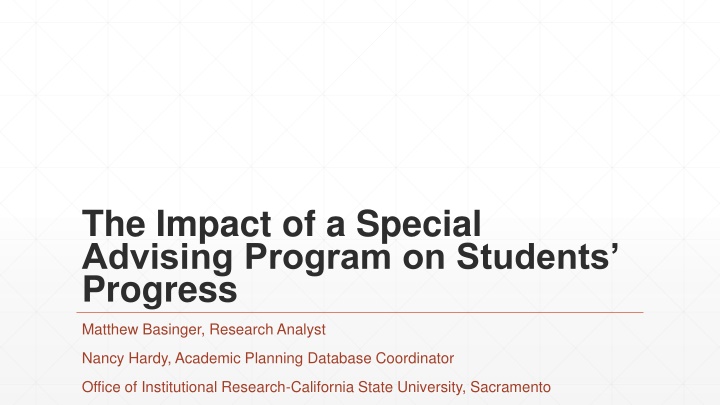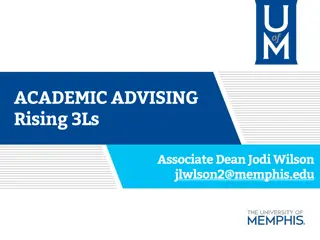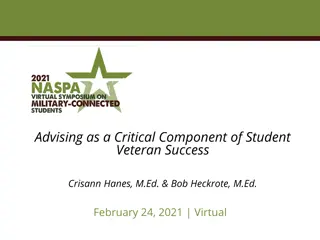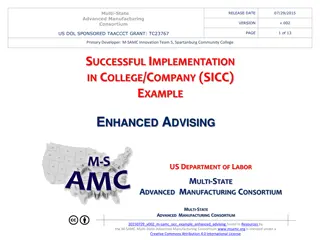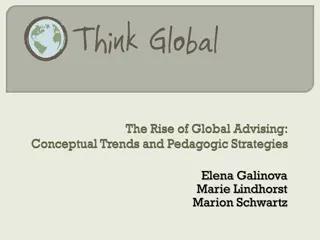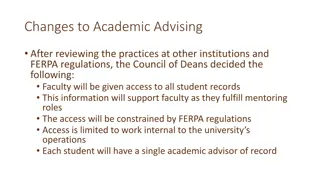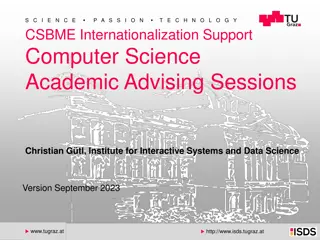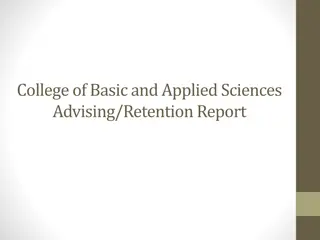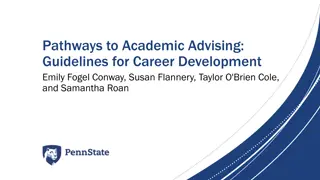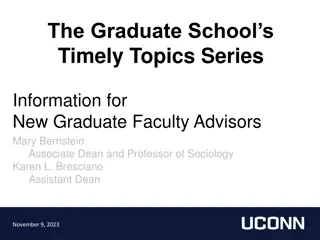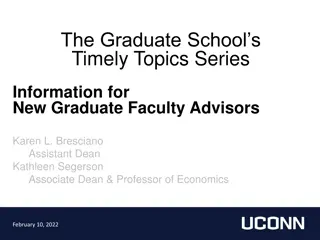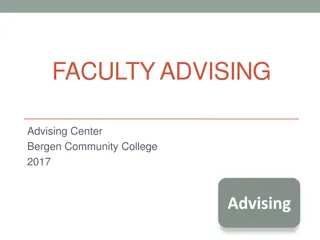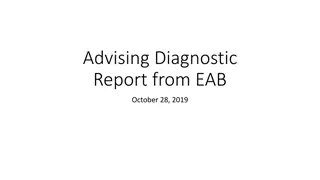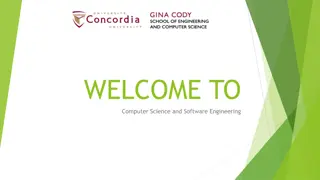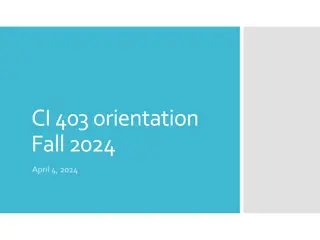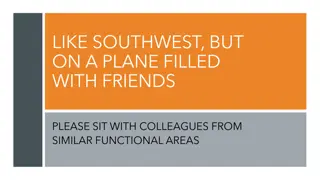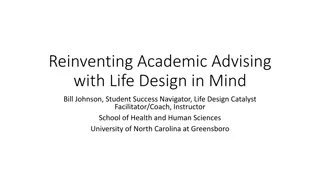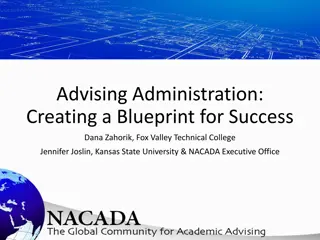Impact of Special Advising Program on Student Progress
Office of Institutional Research and Academic Advising Center collaboration to study and enhance Undeclared Express Interest Second Year Program's effect on student progress at California State University, Sacramento. Focus on encouraging major declaration and career exploration. Activities include one-on-one/group advising, GPA calculation, True Colors assessment, and General Education evaluation.
Download Presentation

Please find below an Image/Link to download the presentation.
The content on the website is provided AS IS for your information and personal use only. It may not be sold, licensed, or shared on other websites without obtaining consent from the author.If you encounter any issues during the download, it is possible that the publisher has removed the file from their server.
You are allowed to download the files provided on this website for personal or commercial use, subject to the condition that they are used lawfully. All files are the property of their respective owners.
The content on the website is provided AS IS for your information and personal use only. It may not be sold, licensed, or shared on other websites without obtaining consent from the author.
E N D
Presentation Transcript
The Impact of a Special Advising Program on Students Progress Matthew Basinger, Research Analyst Nancy Hardy, Academic Planning Database Coordinator Office of Institutional Research-California State University, Sacramento
California State University, Sacramento Founded 1947 Designated a Tree Campus USA 300 acres with 3,500 trees Seven academic colleges 58 undergraduate majors More than 30,700 students enrolled US News ranked for Diversity One of three CSU campuses
Introduction The Office of Institutional Research, in conjunction with the Academic Advising Center, collaborated to examine how the Undeclared Express Interest Second Year Program influenced student progress 2ndyear/sophomore students the target population Mission is to encourage students to declare a major they intend to complete within 45 units Career exploration Major exploration Participants received one-on-one advising or group advising, and participated in activities including GPA calculation, True Colors, Catalog Review, and General Education Evaluation
Why do we care? Improving student outcomes is important to all CSU and UC campuses and this assessment report adds to the field of IR as outcomes are increasingly examined and discussed. The results of this study could be used to enhance the special advising program utilized by the Academic Advising Center. Our office wants to assist various entities on campus with data and research
GPA Calculator Most of the students the Academic Advising Center work with are working towards an impacted major (Expressed Interest Biology, Business Administration, Criminal Justice, Health Science, Psychology and Nursing). If their GPA is below the minimum GPA cutoff, then they calculate their GPA to project the grades that will need to be earned to be as competitive as anybody else applying to the program.
True Colors True Colors is used primarily with students who are Undeclared and in need of major and career exploration. True Colors is a personal/career assessment that allows students to gain a deeper understanding of themselves. By taking the assessment they will discover their True Colors Spectrum (the spectrum is made up of four colors: green, gold, orange and blue). Once the spectrum has been discovered, a list of majors/careers become available for students to review and consider.
Catalog Review The Sacramento State catalog is an important resource when meeting with students for information on General Education (GE)/Graduation Requirements (GR) and major requirements. The catalog provides students with a list of GE/GR and major courses. The Advising Center shows students how to navigate the catalog to find answers to their academic questions.
General Education Evaluation The Advising Center, as part of the advising session, goes over General Education (GE)/ Graduation Requirements (GR) and advises students on unmet requirements. They assist them with course planning to ensure unmet requirements are met on a timely manner.
Participants Profile 1,713 participants were first-time freshman Table 1 Participants Participants Count % Non-Participants Count % Cohort First-Time Freshmen Cohorts 2012 2013 2014 2015 Total Advising Term Spring 2015 Fall 2015 Spring 2016 Fall 2016 Spring 2017 Total 18 were transfers 120 436 565 547 1,668 3.8% 13.0% 15.3% 14.5% 11.9% 3,031 2,930 3,130 3,234 12,325 96.2% 87.0% 84.7% 85.5% 88.1% 3,151 3,366 3,695 3,781 13,993 7 were unknown Study focused on first-time freshman 320 287 353 670 83 1,713 18.7% 16.8% 20.6% 39.1% 4.8% 100.0% Majority (n=1,668) belonged to 2012-2015 native freshman cohorts Note: Participants include 18 transfers and 7 transitory/unknown students. They were excluded from the comparison analysis.
Methodology Used a case control matching program in SPSS Fuzzy Matching Table 3 Selected Matched Groups by Cohort Selected 1,668 advising participants and 1,704 non-participants Participants Non-Participants Total Cohort 120 127 247 2012 Tracked students for 2 semesters, first being the advising semester and the subsequent semester following 436 432 868 2013 565 578 1143 2014 Study used 6 measurements Overall GPA Overall units Term unit completion Academic Standing Major status Persistence rate 547 567 1114 2015 1668 1704 3372 Total
Fuzzy Matching Matches records according to a set of variables Generated matching set from comparison group (new file) Deleted non-match from original data file Merged two files together by using intervention group as host file SPSS Syntax FUZZY BY=Commuter FirstGen Gender Pell NeedRemediation HSGPA ACTScore URM SUPPLIERID=EMPL_ID NEWDEMANDERIDVARS=Match_ID GROUP=Advising_ind FUZZ=0.9 0.9 0.9 0.9 0.9 0.8 80 0.9 DS3=supplier_Match /OPTIONS SAMPLEWITHREPLACEMENT=FALSE MINIMIZEMEMORY=TRUE SHUFFLE=FALSE.
Comparison of Profiles Table 4 Comparison of Profiles for Matching Groups Participants Non-Participants Statistical Significance Count % Count % Gap Ethnicity URM Non-URM Gender Female Male First Generation of College Student Yes No Unknown Low Income (Pell Grant Recipients) Yes No Commuting Status Commuter Living on Campus College Readiness Need Remediation None 701 967 42.0% 58.0% 682 1,022 40.0% 60.0% 2.0% No 1,123 545 67.3% 32.7% 1,175 529 69.0% 31.0% -1.6% No 617 947 104 37.0% 56.8% 6.2% 620 1,058 26 36.4% 62.1% 1.5% 0.6% No 936 732 56.1% 43.9% 987 717 57.9% 42.1% -1.8% No 1,236 432 74.1% 25.9% 1,362 342 79.9% 20.1% -5.8% Yes 1,035 633 62.1% 37.9% 1,114 590 65.4% 34.6% -3.3% No Count Mean Count Mean Gap Test Scores 3.25 448 459 -0.01 -6 -5 No No No HS GPA SAT Verbal SAT Math 1,668 1,604 1,604 3.24 442 453 1,704 1,704 1,704
Comparison of Academic Performance Spring 2015 For the group in Spring 2015, Overall Unit Completion was significantly higher (53 vs. 38 for the advising term and 66 vs. 53 for subsequent term) 2015s Group: Term-to-Term Persistence Paticipants Non-Participants 100% 89.2% 86.5% 90% Academic Standing during the advising term was significantly higher for participants compared to non-participants (92.5% vs. 86.8%, respectively) 80% 71.4% 68.8% 70% 60% Participants had a higher persistence rate from Spring 2015 to Fall 2015 (89.2% vs. 71.4%) and from Fall 2015 to Spring 2016 (86.5% vs. 68.8%) 50% 40% 30% 20% 95% of participants were undecided in Spring 2015, but only 54% remained undecided in Fall 2015, with 138 participants declaring a major 10% 0% Following Term The Third Term
Comparison of Academic Performance Fall 2015 Overall GPA was higher for non-participants at both terms (2.72 for participants vs. 2.81 for non- participants during the advising term and 2.73 vs. 2.83 the following term) 2015f Group: Term-to-Term Persistence Paticipants Non-Participants Overall unit completion was higher for participants than non-participants (53 vs. 38 units for the advising term and 64 vs. 50 units the following term) 100% 92.6% 90% 78.2% 77.3% 80% Term unit completion was lower for participants (participants had 11 vs. 13 units for non-participants in the advising term, followed by 11 vs. 12 units) 69.1% 70% 60% 50% Academic standing was higher for participants (93.2% vs. 88.8%) 40% 30% Reduction in undecided majors (33.5% to 20.8%) 20% 10% Higher persistence rate from Fall 2015 to Spring 2016 (92.6% vs. 77.3%) and Spring 2016 to Fall 2016 (78.2% vs. 69.1%) 0% Following Term The Third Term
Comparison of Academic Performance Spring 2016 Participants had a higher Good Standing Rate (95% vs. 89%) 2016s Group: Term-to-Term Persistence Paticipants Non-Participants 100% Non-participants accumulated more Overall Units in the following term and more units completed during both terms (50 vs. 49 units and 66 vs. 62 units, respectively) 90.6% 90% 80% 69.1% 70% 60% 50% 45% of special advising participants were undecided in the advising semester, but only 16% remained as undecided in the following semester 40% 30% 20% 10% 0% Following Term Had a higher persistence rate (90.6% vs. 69.1%)
Comparison of Academic Performance Fall 2016 Data availability at time of assessment was not prevalent, therefore there are fewer findings and comparative analysis is incomplete 2016f Group: Declaration of Major Paticipants Non-Participants 8% 6.8% 7% Non-participants had significantly higher Overall Unit Completion (66 vs. 44 units) 6% 5% Additionally, non-participants had higher Term Unit Completion (14 vs. 13 units) 4% 3% 2% Participants had more individuals with a declared major during the advising term (6.8% vs. 0.8%) 0.8% 1% 0% Following Term
Discussion and Recommendations Majority of participants were undecided (as high as 95%) when they received special advising After the session, 13% to 41% declared a major at the following semesters, which is much higher than non-participants at less than 3% Participation rate increased from 16% to 68% from 2012-2015 The term-to-term persistence rate was about 18% higher for participants (9% to 15% higher for Fall 2015 and 22% higher for Spring 2016)
Participant Declaration of Major Declared Majors after Special Advising Program 2015s Group 2015f Group 2016s Group 90% 84.5% 80% 79.2% 70% 66.5% 60% 54.8% 50% 46.2% 40% 30% 20% 10% 5.1% 0% Advising Term Following Term
Conclusion The special advising is a very effective intervention, in terms of helping students choose majors after 1 year and increasing their persistence rate at the university According to the findings of this study, the special advising should expand its service to reach all undecided students during their second year despite the participation rate has increased significantly.
Questions? Matthew Basinger, Research Analyst matthew.basinger@csus.edu Nancy Hardy, Academic Planning Database Coordinator nhardy@csus.edu
